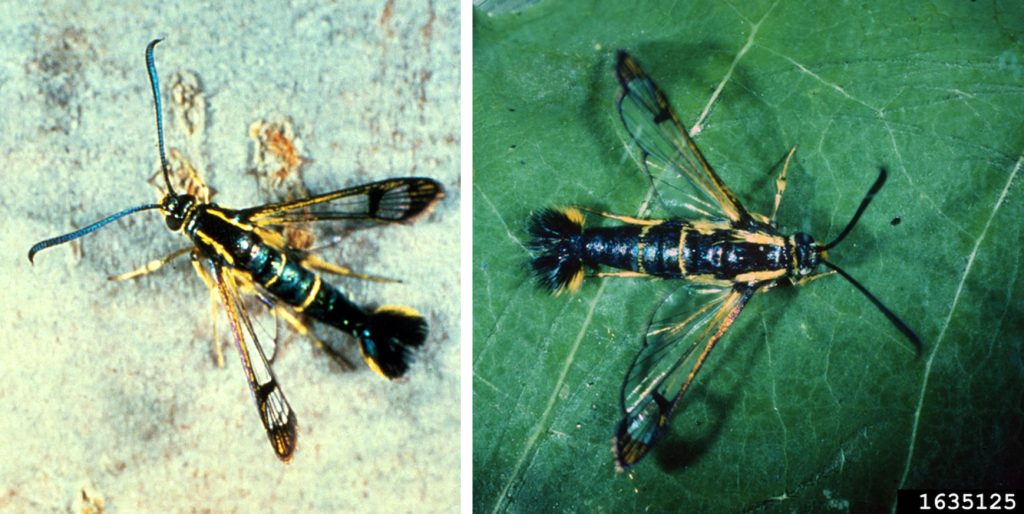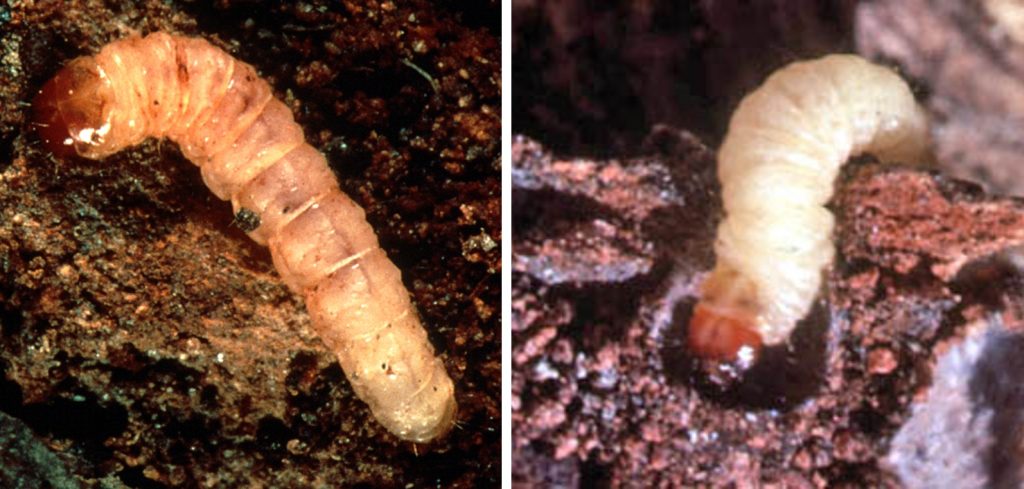The dogwood borer, Synanthedon scitula (Harris), can be a destructive pest of many ornamental trees in nurseries and landscapes. Adults of dogwood borer are moths (Fig. 1). Because the wings of these moths are clear, they are referred to as clearwing moths. The name “dogwood borer” was derived because they readily attack flowering dogwood, Cornus florida L., common in residential yards, public parks, and wooded areas. The dogwood borer also attacks fruit and nut trees in landscapes and commercial orchards. The dogwood borer is native to North America and common in eastern Canada and the United States. It is present throughout Georgia.

Life cycle
Moths of dogwood borer are robust fliers and active during the dawn. Adults of dogwood borer are bluish-black, ~1.5 cm long, and look like a wasp. The wing span is ~1.5 cm. The abdomen of adults has golden-yellow bands on the second and fourth segments. Yellow bands are also present on the legs. In the spring, adults emerge from trees, and females look for suitable tree bark to lay eggs. Adults are active from April to October. Any wounded areas on the bark are preferred for egg laying over other areas of the bark. The female moths singly lay pale yellow, oval-shaped, ridged eggs on the bark near the wounded area. Eggs hatch within nine days, and the white or cream-colored larvae bore into the wound and feed on bark after making galleries. They are white with a brown head and have two reddish-brown spots on the back, near the head (Fig. 2). The larvae molt through seven instars and grow up to 1.5 cm in length at the seventh instar. The late instar larvae prepare cocoons with silken thread and excrement, where they overwinter. Before developing into the pupal stage, late instars feed on the bark and then pupate inside the silken cocoon near the surface of the bark. The pupae are slightly brown and approximately 1 cm long. After 30 days, an adult moth emerges from the pupae, leaving the pupal case behind. Part of the pupal case is visible from the bark. Typically, dogwood borer has one generation yearly in the northeast, but multiple generations are suspected in Georgia.

Hosts Plants
The dogwood borer attacks many ornamental trees, such as American beech (Fagus grandiflora), black willow (Salix nigra), blueberries (Vaccinium spp.), American chestnut (Castanea dentate), hickories and pecans (Carya spp.), pines (Pinus spp.), mountain ash (Sorbus spp.), hazel (Corylus spp.), birch (Betula spp.), loquat (Eriobotrya japonica), oaks (Quercus spp.), elm (Ulmus spp.), cherry (Prunus spp.), apple (Malus domestica), bayberry(Morella spp.), and myrtle (Myrtus spp.). There are more than 250 species listed as hosts of this borer.
Damage
The dogwood borer prefers to attack wounded or scarred bark near the tree’s base. This pest also uses regions where limbs branch out from the main trunk to enter inside the tree. Because dogwood larvae tunnel around vascular bundles of trees, the affected region swells up, causing gall-like symptoms. In apple, the burr knot region is mainly infested. Infested bark with early instars appears wet during the summer. The tunnels are typically filled with excrement and sawdust. Some other symptoms include the change in leaf color (from green to red), dieback in the crown region, and production of adventitious growth. The infested bark swells up and falls off from the trunk. With time, the affected tree trunk appears devoid of bark layer. Repeated infestation often destroys the bark, blocking the movement of photosynthates and water. Those severely affected trees may die over years of repeated infestation.

Management
General best management practices, such as adequate fertilization and irrigation, especially during dry spells, will reduce tree stress. If the infestation is less severe and on a limited number of trees, a fine wire can be used to pull out the larvae from the infested area. Kousa dogwood appears resistant to this borer.
Infestation can be reduced by preventing any injury to bark when mowing or trimming around the base. The weeds can be reduced with proper mulching around the base of the tree trunk to avoid mechanical injury from landscape maintenance equipment. Diseased and dead branches should be removed from the tree during winter. Avoid pruning in the spring, as these new wounds can attract females, resulting in egg laying and infestation. This pest can be monitored using traps with commercially available sex pheromone lures.
Although biological control agents, such as birds (woodpeckers and nuthatches), prey on the larvae, they do not effectively control the dogwood borers. Moths are vulnerable to predation from birds, bats, insects, etc. Applications of entomopathogenic nematodes, such as Steinernema carpocapsae are advised on infested areas of tree trunks to target developing larvae in the summer. Repeated applications with full coverage are warranted for effective control.
A barrier spray with a contact insecticide can effectively prevent infestation if applied correctly in the spring before eggs are laid, but the barrier must be complete and cover the trunk up to and including the scaffold limbs. Newer classes of insecticides with systemic activity are also effective. Soil drench of imidacloprid, recommended for flatheaded apple borer, is ineffective on clearwing borer larvae. Contact your local Extension office for the latest control recommendations. Reading the insecticide label before spraying is important because it is the law.
References
Anonymous. Dogwood borer. Missouri Botanical Garden. https://www.missouribotanicalgarden.org/gardens-gardening/your-garden/help-for-the-home-gardener/advice-tips-resources/pests-and-problems/insects/caterpillars/dogwood-borer
Anonymous. 2016. Dogwood borer. UConn Home and Garden Education Center. https://homegarden.cahnr.uconn.edu/factsheets/dogwood-borer/
Bergh, J. C., and T. C. Leskey. 2003. Biology, ecology, and management of dogwood borer in eastern apple orchards. The Canadian Entomologist 135: 615-635.
Brown, L. N., and R. F. Mizell III. 1993. The clearwing borers of Florida. Tropical Lepidoptera 4, supplement 4.
Childs, R. 2011. Dogwood borer. UMass Extension Landscape, Nursery and Urban Forestry Program. https://ag.umass.edu/landscape/fact-sheets/dogwood-borer
Day, E. 2006. Dogwood borer. Virginia Cooperative Extension. Publication 444-217. https://www.sites.ext.vt.edu/departments/entomology/factsheets/dogborer.html
Gyeltshen, J., and A. Hodges. 2006. University of Florida. EENY-374. https://entnemdept.ufl.edu/creatures/trees/moths/dogwood_borer.htm
Neal, J. W. 1984. Bionomics and instar determination of Synanthedon rhododendri (Lepidoptera: Sesiidae) on rhododendron. Annals of the Entomological Society of America 77: 552-560.
Riedl, H., R. W. Weires, A. Seaman, and S. A. Hoying. 1985. Seasonal biology and control of the dogwood borer, Synanthedon scitula (Lepidoptera: Sesiidae) on clonal apple rootstocks in New York. The Canadian Entotmologist. 117:1367-1377.
Snow, J. W., T. D. Eichlin, and J. M. Tumlinson. 1985. Seasonal captures of clearwing moths (Sesiidae) in traps baited with various formulations of 3, 13-octadecadienyl acetate and alcohol. Journal of Agricultural Entomology 2: 231-232.